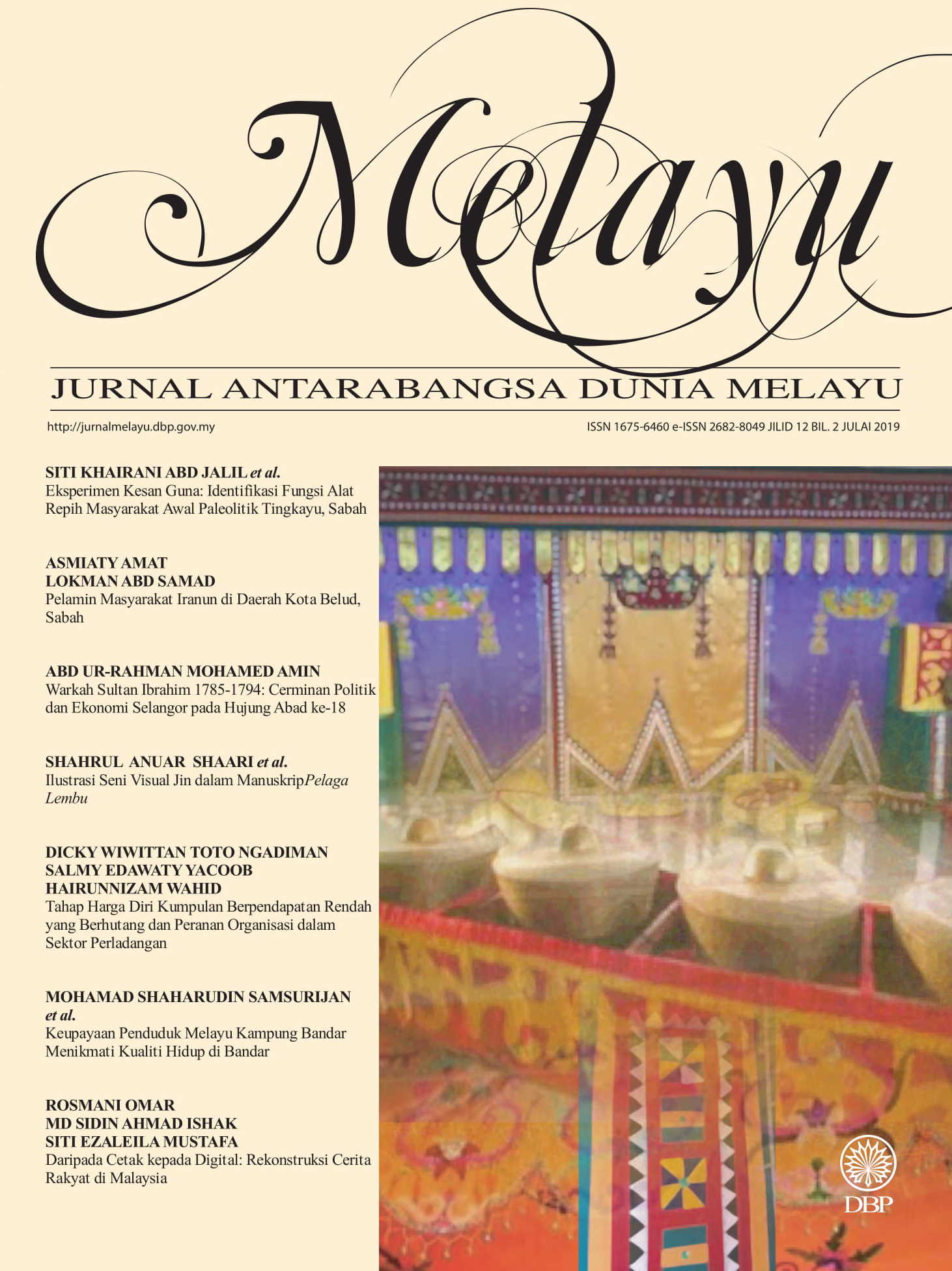Visual Illustrations of Jinn in the Pelaga Lembu Manuscript
(Ilustrasi Seni Visual Jin dalam Manuskrip Pelaga Lembu)
Abstract
Illustrations of supernatural beings called jinns (genies) have long existed in the manuscripts of the Malay world. One such manuscript is Pelaga Lembu (MS1649) from Kelantan-Patani, which was composed from around the 1860s to the 1920s, and is a single manuscript describing the rites and rituals surrounding the readying of bulls for bullfighting. This manuscript contains text and illustrations of jinns, fulfilling various purposes and roles, that dominate almost every page of the manuscript. The illustrations of jinns were provided by writer-illustrators considered in the olden days to be "experts" in this field, such as shamans, mediums and medicine men, as a means to record-in visual means-the ways of handling fighting bulls. The characteristics and illustrations of jinns are interpreted, and communicated in a symbolic artistic medium through the folk art style. The image shows the variety of influences on the beliefs of the local community, with its tribal and ethnic diversity. The jinn illustrations are visual expressions displaying the belief system that lay at the very basis of the cultural practices in the Malay world some time ago. This proves that these authors were artists of their day, and that the Malay visual arts developed through writing and drawing.
Keywords: Illustrations, jinn, Malay manuscripts, arts
References
Abdullah Muhammad. (1978). Falsafah dan pemikiran orang-orang Melayu: Hubungan dengan Islam dan kesenian. Kementerian Belia dan Sukan, Malaysia.
Amran Kasimin, 1992. Liku-liku iblis menipu manusia, Kuala Lumpur: Dini Publisher.
Annabel, G. T. (2013). The language of Malay manuscript Art: A tribute to Ian Proudfoot and the Malay Concordance Project. International Journal of the Malay World and Civilisation (Iman), 1 (3), 11-27.
Beamish, T. (1954). The arts of Malaya. Singapore: Donald Moore.Ltd.
Brown, C. C. (1928). Kelantan Bull-Fighting. Journal of the Malayan Branch of the Royal Asiatic Society, VI, 1-86 were published 1878-1922. Singapore: Frasir& Weave, Lin Printer.
Clifford. H. (1927). In court and kampung. London: The Richards Press.
Danaraj A.G.S. (1964). Mysticism in Malaya. Singapore. Singapore Asia Pub.
Farouk Yahya. (2016). Magic and divination in Malay illutrated manuscript: Leiden: Brill.
Greertz, Clifford. (1977). Interpretation of culture, selected essays. New York: Basic Book, Inc.
Haron Daud. (2001). Mantera Melayu: Analisis pemikiran. Pulau Pinang: Penerbit Universiti Sains Malaysia.
Glassie,H. (1989). The spirit of folk art. New York: Abrams.
Hashim Musa (1997). Sejarah awal kemunculan dan pemapanan tulisan Jawi di Asia Tenggara. Tradisi penulisan manuskrip Melayu. Kuala Lumpur: Perpustakaan Negara Malaysia.
Hilman Hazmi dan Hendro Aryanto. (2017). Perancangan buku ilustrasi kehidupan jin untuk remaja. Jurnal Seni Rupa, 05(03), 510-518.
Maxwell, W.E. (1878). A Malay keramat. Journal of The Straits Branch of the Royal Asiatic Society, 2, 236-238.
Mitchell. (2002). What do pictures want: The lives and loves of images. Chicago: University of Chicago Press.
Mohd Fadil. (2010). Rahsia & khasiat huruf-huruf Hijaiyyah (Siri Perubatan Islam). Kelantan: Al-Baqir Enterprise. p.97.
Mohd Nizam Sahad. (2014). Penggunaan azimat pelaris perniagaan menurut perspektif akidah Islam. Jurnal Antarabangsa Dunia Melayu, 8(1), 18-44.
Mohd Zohdi (2014). Jin menurut perspektif sunnah dan budaya Melayu: Analisis kesan kepercayaan dalam kalangan remaja (Tesis PhD tidak diterbitkan). Kuala Lumpur: Jabatan al-Quran dan al-Hadis Akademi Pengajian Islam, Universiti Malaya.
Morgan. D.(ed.). (2010). Religion and material culture: The matter of belief. New York: Routledge.
Muhammad Azizan Sabjan, Noor Shakirah, (2018) Rawatan Islam dan gangguan makhluk halus dari perspektif Islam, e-Prosiding Seminar Falsafah dan Tamadun 2018 (SEFATA 2018), (pp.512-518) | 12 November 2018 | Universiti Sains Malaysia eISBN 978-967-10912-7-2
Muhammad Isa Dawud. (1997). Alladhin Sakan al-Ard Qablana. Diterjemah Irwan Kurniawan. Bandung: Pustaka Hidayah.
Nik Mohamed Nik Mohd Salleh. (1992). Manuskrip Melayu dari Kelantan: Satu tinjauan Awal. Jurnal Filologi, 1. Kuala Lumpur: Perpustakaan Negara Malaysia.
Richard, M.D. (ed). Glassie, H. (1972). Folklore and folklife: An Introduction. Chicago: University of Chicago Press.
Swettenham, F. (1895). Malay sketches. London: J. Lane. pp.147–192.
Seyyed Hossein Nasr. (1997). Pengetahuan dan kesucian. Yogyakarta: Pustaka Pelajar.
Wan Adli Wan Ibrahim, (1968). A buffalo-fight in Kedah, Kedah dari segi sejarah. 3 (1). The Magazine of the Kedah Branch of the Malaysian History Society.
Wan Mohd Dasuki, Siti Radziah.(2014). Kearifan Melayu dalam pembinaan konsentrasi dan ketepatan: Aplikasinya dalam ritual menembak. Nazarudin Zainun & Darlina Md. Naim (Eds.). Merekayasa kearifan tempatan: Budaya, pelancongan, arkeologi dan sejarah. Pulau Pinang: Penerbit Universiti Sains Malaysia.
Skeat,W.W. (1900). Malay magic: Being introduction to folklore and popular religion of the Malay Peninsula. London: Macmillan.
Winstedt, R.O. (1909). Arts and craft (paper on Malay subject: Malay Industries: Part 1) Kuala Lumpur: F.M.S. Government Press.
Winstedt, R.O. (1925). Shaman saiva and sufi: A study of the evolution of Malay magic. London: Constable & Company Ltd.








